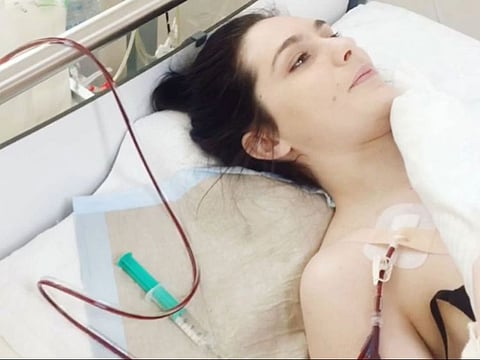Living with Lyme disease: A tick bite at age 2 left South African expat Kimberly Roos Horwitz bed-bound at 27
Abu Dhabi-based expat is now trying to have a baby, after healing herself

“I was in a living hell. My heart was constantly racing and pounding and I was gasping for air with every breath,” says South African expat Kimberly Roos Horwitz, recalling her 27th year.
The tick bite was an annoyance to two-year-old Roos Horwitz more than anything else; it kept itching and distracting her from what was really important – playing. A few hours on, that irritation had turned into something more sinister. “My parents remember that I wasn’t eating, I had a fever and couldn’t hold my head up. My mum said that I just wasn’t myself at all and I had a rash all over my body,” she says.
She healed over the next few days, the upset skin being quelled by her mum’s lotions and the family didn’t think much of it. Over the next few years, however, there were flare-ups. “As a child I developed severe asthma and felt different in terms of not being able to keep up in sports activities, although I still pursued sports and activities and managed to find much success in competitive sports. However, keeping up with training was always very difficult. I struggled with fatigue, breathing issues and developed rashes and allergies. I was often sick with chest infections and had to take time off regularly. It was very frustrating but we thought that I simply had asthma and allergies. Then panic attacks started to show up at age 12 and anxiety became a big part of my life,” she says.
Then came the incident at age 27. Roos Horwitz was driving along the Corniche road in Abu Dhabi when her heart began to thunder and she stepped on the brakes. “I remember a lot of people getting angry and honking at me. A very kind stranger called the ambulance for me and they said my heart rate and blood pressure were unstable. At the time, there was no explanation as to what caused it,” she recalls.
I eventually couldn’t push myself anymore. I would blank out if I even tried to sit up in bed. I wasn’t able to wash myself, I hated eating

From this point on, her life spiraled out of control – soon she found herself bed-bound, often gasping for breath and in tears. “I eventually couldn’t push myself anymore. I would blank out if I even tried to sit up in bed. I wasn’t able to wash myself, I hated eating,” she says. “In fact, I really thought that at any minute it could be the end for me.”
Doctors diagnosed her with chronic fatigue syndrome.
What is Chronic fatigue syndrome?
Chronic fatigue syndrome (CFS) is a complicated disorder characterised by extreme fatigue that lasts for at least six months and that can't be fully explained by an underlying medical condition. The fatigue worsens with physical or mental activity, but doesn't improve with rest. Other characteristic symptoms include: Sleep that isn't refreshing Difficulties with memory, focus and concentration Dizziness that worsens with moving from lying down or sitting to standing Source: Mayo Clinic
As days blurred into months, there seemed to be no respite in sight. Until a call from her mother gave Roos Horwitz some hope. “My mum told me about a family friend who was in a similar position and was diagnosed with the same [chronic fatigue syndrome] until her parents found a doctor for her who ran tests and found Lyme disease and co-infections and treated her successfully,” she says.
So she went to the same doctor, who ran the same tests. Finally, she understood what was happening to her – left untreated, the bacteria from the tick bite over two decades ago had spread and was now affecting her nervous system. Those flare-ups in school weren’t allergies, she realised, they were symptoms of Lyme disease. The more she read about what it was, the more she understood the tornado-like effect it had on her quality of life.
What is Lyme disease?
Lyme disease is caused by the bacterium Borrelia burgdorferi and rarely, Borrelia mayonii. It is transmitted to humans through the bite of infected blacklegged ticks. Typical symptoms include fever, headache, fatigue, and a characteristic skin rash called erythema migrans. If left untreated, infection can spread to joints, the heart, and the nervous system. Source: CDC
Determined to get better, she started treatment. Which failed. So she tried another. Which failed. And another… “By the time 2021 came around, I had spent years and years and tons and tons of money on treatments. I had tried all the treatments under the sun – I had gone to world-class facilities in Germany, I did hyperthermia treatment, I did plasmapheresis, acupuncture, ozone therapy, antibiotic therapy, disulfiram treatment,” she recalls, adding that nothing worked. “I held a fundraiser for donations [in South Africa] for my treatment at the Germany facility and I paid for most of that treatment too. For the rest of the treatments, my husband and my entire salaries were used up,” she says.
“I had to step down from my job [in 2021], I was at a loss; I basically had given up on life; I was having daily panic attacks, thinking, ‘what if this lasts forever?’, ‘what if this is just my life?’ The suffering was extreme – the symptoms were really vast and really intense, debilitating. And so I was just sitting in bed all day, with nothing to do just having overwhelming symptoms and extreme panic attacks and I kept calling the ambulance thinking that I was dying, and I didn’t want to do that to my husband.”
Doctors, she says, kept putting her on medication. “‘Three months after starting this medication, you will feel like a new person, they said’,” she adds. “This was also a source of extreme emotional struggle for me because I kept getting hopeful and then my dreams were crushed.”
Turning point
“When I kept not dying, I knew that I absolutely had to make a plan to get some quality of life back. And that’s when the researching began,” she says.
Introspection was key to Roos Horwitz’ recovery. She explains: “My husband who was really my rock through it all – he was there for anything I needed and still is – he is a huge part of what got me through. But besides that, I realised that I am the only one that can heal myself. It had taken almost a lifetime to get me to where I was bed-bound and it was going to take a lot to get me out of it, but the only person who knew me was me. [I began] working on all aspects and all levels of myself, the physical symptoms and really supporting myself physically, changing my lifestyle, eliminating stress, I even moved apartments to a more healing environment by the water, a place that’s more light and airy. I hired someone to be with me 24/7 so I have someone with me all the time to support. I gave myself that self-love and self-care and the support that I needed to take this into my own hands and empower myself.
“Then I started to educate myself on healing at all levels. Healing on the level of the nervous system, healing on the level of trauma - I started to read up, I started to meet a somatic experiencing practitioner – I highly recommend this to anyone who has physical symptoms and any mental health issues because both are linked.”
What is somatic experiencing?
Somatic experiencing, created by Dr Peter A. Levine, is based on the supposition that in addition to the fight or flight responses, all humans have a third response to a perceived threat: to freeze. However, this reaction is time-sensitive, it needs to run its course, and the massive energy that was prepared for fight or flight gets discharged, through shakes and trembling. If the immobility phase doesn’t complete, then that charge stays trapped, and, from the body’s perspective, it is still under threat. The Somatic Experiencing method works to release this stored energy and turn off this threat alarm that causes severe dysregulation and dissociation, says the website Somatic Experiencing International.
“After about two or three sessions of somatic experiencing, the panic attacks completely disappeared,” she says. “I was also doing rapid transformational therapy in conjunction with it, but I credit the somatic experiencing to my continued success.”
What is rapid transformational therapy?
This type of therapy combines hypnotherapy, psychotherapy, Neuro-linguistic programming and Cognitive behavioural therapy to benefit mental health and well-being.
Today, Roos Horwitz sees a whole new world, one filled with possibility. “I go for walks every day now and enjoy getting out and enjoying life,” she says, adding that she’s trying to conceive. She advocates for others struggling with chronic illness who aren’t finding any answers or seeing improvements and shares her own experiences of living with a chronic disease at treatmeASAP.com.
She says she’s had many mums reach out to her on social media, asking about tick bites and symptoms of Lyme disease. “It’s not as uncommon as you’d think. It’s the fastest growing infectious disease in the US right now (besides COVID-19). And I’ve actually been contacted by multiple people within the UAE whose children have had ticks attached to their feet or tick bites and they ask me about what to do. It’s very important to raise awareness about this disease.”
Kimberly’s advice to mums
My advice to mums whose children have been bitten by a tick/ticks is not medical nor professional advice but rather advice based on my personal experience as well as my experience learning from professionals across the board in this area of expertise. Finding a Lyme Literate Medical Doctor (LLMD) and following their guidance is always recommended for safety and guidance on your individual case. Functional medicine doctors tend to sometimes be knowledgeable on the topic too, but they need to be carefully sought out. Joining Lyme Disease-related Facebook groups can point you in the right direction for finding an accessible and knowledgeable expert. Be aware that they are very rare . However, my advice would be to get educated first and foremost. This will allow you to make the most informed decisions for your child. Educate yourself on all areas of health, including the common lifestyle aspects like diet, daily toxin exposure, movement as well as trauma healing and nervous system regulation. This will allow your child’s body to use its own natural healing intelligence to fight the infection. If you are lucky enough to catch the infection early, within the first 24 hours of the tick being attached, treatment is more straightforward and usually involves either high dose combination antibiotics (again, this needs to be prescribed by a professional who is specifically educated on tick-borne infections) or alternative treatments that have been proven to successfully treat tick-borne infections. Functional medical doctors who are knowledgeable on this topic will be able to point you in the right direction in terms of alternative treatments. Finally, my top tip to parents is to be prepared. Gain the knowledge before any incident has occurred, because if it does, swift action will have the best possible outcome. Ticks are everywhere and contrary to popular beliefs, tick-borne infections are very common worldwide. It’s time the public had access to the education and resources needed in order to prevent and tackle these infections effectively.
The journey has been a tough one, she says. "I would’ve never chosen this challenge in a million years but it’s been a source of enormous growth and empowerment," she says. And today is a good day.
Tell us your story - write to us at parenting@gulfnews.com
Sign up for the Daily Briefing
Get the latest news and updates straight to your inbox



